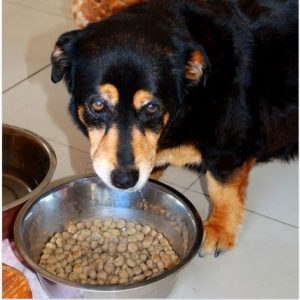Dog owners often wonder about the pros and cons of free-choice feeding dogs, and while there are many disadvantages with this method of feeding, free-choice feeding can also be advantageous in a few circumstances. Some websites condemn free-choice feeding as being a “disservice to dogs” and accusing owners of free-choice feeding as not being responsible; some others even go on to claiming it to be a “recipe for disaster,” however, most likely, not all circumstances are being evaluated. Read on to learn when free-choice feeding may be a sensible option for your dog.
 What is Free-Choice Feeding?
What is Free-Choice Feeding?
As the name implies, free-choice feeding means that the dog gets to eat when he wants and how much he wants. Also known as “ad libitum feeding” or “self feeding,” free-choice feeding entails leaving the dog with a full bowl of food all day and the dog gets to eat as much as he wants and whenever he chooses to.
The routine goes something like this: the dog owner wakes up and before going to work, he fills up the food bowl with dog food. He then leaves for work and when he comes back, he checks the food bowl. If there is some food left, he may leave it out for the rest of the night, or if there is no food, he may add some more. Then in morning, he refills the bowl for another day.
The main job of free-choice feeding is therefore for the dog owner to always ensure that a fresh supply of food is always available to the dog. And the dog’s “job” of course is to simply eat when he feels like it!
Advantages of Free-Choice Feeding
You may find it odd that there are advantages for free-choice feeding, when so many websites claim quite the opposite. Perhaps one of the biggest advantages of free-choice feeding dogs is the fact that it is quick and easy. All dog owners need to do is make sure that the dog’s food bowl always contains a supply of fresh food.
Certified veterinary technician Dr. Mari Sirois explains in the book “Elsevier’s Veterinary Assisting Textbook,” how free-choice feeding is the method of choice for feeding dogs when they are nursing. When dogs are nursing, they may need to eat several small meals during the day on an “as needed basis.” This because new mother dogs may wish to limit the length of absences from their newborn puppies’ during their critical stage of growth when they need as much warmth, protection and nourishment as possible.
The manual of Small Animal Clinical Nutrition mentions that free-choice feeding can have a “quieting effect” in dogs living in a kennel environment. Shy dogs may appreciate the opportunity to eat when they feel safe to do so. Feeding free choice can also help relieve boredom and minimize undesirable behaviors such as eating stools and barking.
Free- choice feeding may be an ideal option for “nibblers” and slow eating dogs that will not consume the amount of food necessary to meet their needs when the food bowl is offered only for a limited, specific time frame and then it is taken away, explains Linda P. Case canine nutritionist, dog trainer, and science writer in the book “The Dog: Its Behavior, Nutrition, and Health.”
 Disadvantages of Free-Choice Feeding
Disadvantages of Free-Choice Feeding
There are several disadvantages of free-choice feeding, which is why it has such a bad rap. One big concern is the fact that free-choice feeding makes it difficult for dog owners to detect very subtle changes in food consumption. If your dog is not feeling well, he may just pick at his food but you won’t notice the reduce caloric intake because it is difficult to notice a difference by just looking at the food bowl. You might therefore notice a problem only once your dog has lost a substantial amount of weight.
Free-choice feeding should not be used in puppies. When puppies are growing they require a precise amount of food so to ensure they are not ingesting too little or too many calories. Free-choice feeding doesn’t allow the pup’s food intake to be monitored and this can predispose them to malnutrition or metabolic bone diseases.
While dogs may have the ability to self regulate their consumption of food to meet their caloric needs, these regulatory mechanisms can be overridden when dogs are lacking sufficient mental stimulation, explains Linda Case. This feeding method therefore is not ideal for obese dogs or dogs who are predisposed to becoming obese.
Finally another disadvantage of free choice feeding is the fact that only dry food can be used considering that moist foods tend to be prone to spoilage after being left out for lengthy periods of time.
“The risk of developmental orthopedic diseases appears to be increased in large and giant breed puppies fed highly palatable, energy-dense foods free choice, even if foods are well-balanced. One study noted that if free-choice feeding is used, it should be done only in combination with a low energy-density food to decrease the risk of developmental orthopedic diseasesand obesity.” ~Ed Kane, researcher & consultant in animal nutrition.
How to Transition a Dog to Free Feeding
If you are planning to switch your dog to free choice feeding, you may be wondering what procedure to use. The manual of Small Animal Clinical Nutrition suggests starting by feeding the dog the regular amount fed when meal feeding, and then, after this food has been consumed, and the dog’s appetite seems to have been somewhat satisfied, more food can be set out then to be fed free choice.
While dogs transitioning to free-choice feeding may initially feel like splurging and overeating, generally, this tendency tends to fade once the dogs realize that their food is always readily available. It’s important to refrain removing the food at any time during this time of adjustment as it will only cause the dog to feel tempted to eat again all at once.
 The Bottom Line
The Bottom Line
How dog food is provided and how often it is fed ultimately depends on several factors. Each individual situation therefore dictates which feeding method is the best.
In some cases, the lifestyle of the owner is the determining factor, but it’s important to evaluate if this is in the best interest of the dog. As seen, free choice feeding is not right for all types of dogs.
If you are debating on whether you should feed your dog free-choice, consult with your veterinarian, or better a veterinary nutritionist. In general, most dogs will do best when fed through regular meal feedings, where the dog is usually provided with specific, but lesser, amounts of food according to food label instructions.
References:
- Small Animal Clinical Nutrition, 5th Edition, Mark Morris Institute
- The Dog: Its Behavior, Nutrition, and Health, by Linda P. Case
- Elsevier’s Veterinary Assisting Textbook, By Margi Sirois
- Richardson DC, Zentek J, Hazewinkel HAW, et al. Developmental orthopedic disease of dogs. In: Hand MS, Thatcher CD, Remillard RL, et al., eds. Small animal clinical nutrition. 4th ed. Topeka, Kan: Mark Morris Institute, 2000;505-528.



 What is Free-Choice Feeding?
What is Free-Choice Feeding?
 Disadvantages of Free-Choice Feeding
Disadvantages of Free-Choice Feeding The Bottom Line
The Bottom Line